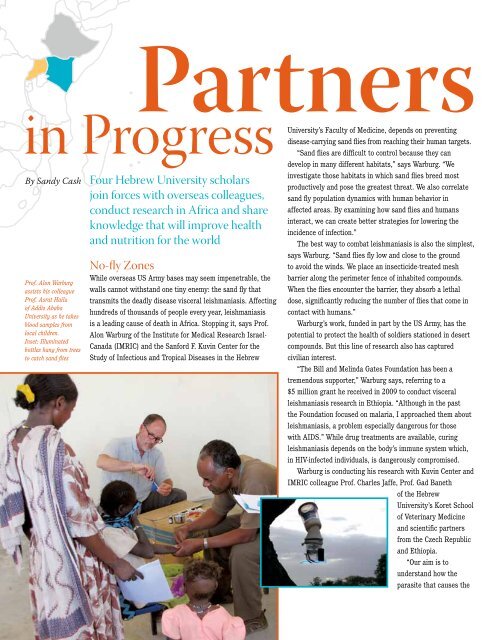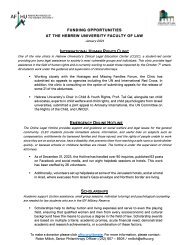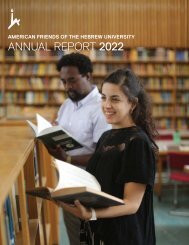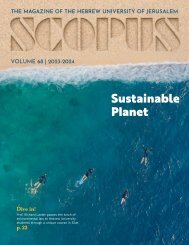Create successful ePaper yourself
Turn your PDF publications into a flip-book with our unique Google optimized e-Paper software.
By Sandy Cash<br />
Partners<br />
University’s Faculty of Medicine, depends on preventing<br />
in Progress<br />
Prof. Alon Warburg<br />
assists his colleague<br />
Prof. Asrat Hailu<br />
of Addis Ababa<br />
University as he takes<br />
blood samples from<br />
local children.<br />
Inset: Illuminated<br />
bottles hang from trees<br />
to catch sand flies<br />
Four Hebrew University scholars<br />
join forces with overseas colleagues,<br />
conduct research in Africa and share<br />
knowledge that will improve health<br />
and nutrition for the world<br />
No-fly Zones<br />
While overseas US Army bases may seem impenetrable, the<br />
walls cannot withstand one tiny enemy: the sand fly that<br />
transmits the deadly disease visceral leishmaniasis. Affecting<br />
hundreds of thousands of people every year, leishmaniasis<br />
is a leading cause of death in Africa. Stopping it, says Prof.<br />
Alon Warburg of the Institute for Medical Research Israel-<br />
Canada (IMRIC) and the Sanford F. Kuvin Center for the<br />
Study of Infectious and Tropical Diseases in the Hebrew<br />
disease-carrying sand flies from reaching their human targets.<br />
“Sand flies are difficult to control because they can<br />
develop in many different habitats,” says Warburg. “We<br />
investigate those habitats in which sand flies breed most<br />
productively and pose the greatest threat. We also correlate<br />
sand fly population dynamics with human behavior in<br />
affected areas. By examining how sand flies and humans<br />
interact, we can create better strategies for lowering the<br />
incidence of infection.”<br />
The best way to combat leishmaniasis is also the simplest,<br />
says Warburg. “Sand flies fly low and close to the ground<br />
to avoid the winds. We place an insecticide-treated mesh<br />
barrier along the perimeter fence of inhabited compounds.<br />
When the flies encounter the barrier, they absorb a lethal<br />
dose, significantly reducing the number of flies that come in<br />
contact with humans.”<br />
Warburg’s work, funded in part by the US Army, has the<br />
potential to protect the health of soldiers stationed in desert<br />
compounds. But this line of research also has captured<br />
civilian interest.<br />
“The Bill and Melinda Gates Foundation has been a<br />
tremendous supporter,” Warburg says, referring to a<br />
$5 million grant he received in 2009 to conduct visceral<br />
leishmaniasis research in Ethiopia. “Although in the past<br />
the Foundation focused on malaria, I approached them about<br />
leishmaniasis, a problem especially dangerous for those<br />
with AIDS.” While drug treatments are available, curing<br />
leishmaniasis depends on the body’s immune system which,<br />
in HIV-infected individuals, is dangerously compromised.<br />
Warburg is conducting his research with Kuvin Center and<br />
IMRIC colleague Prof. Charles Jaffe, Prof. Gad Baneth<br />
of the Hebrew<br />
University’s Koret School<br />
of Veterinary Medicine<br />
and scientific partners<br />
from the Czech Republic<br />
and Ethiopia.<br />
“Our aim is to<br />
understand how the<br />
parasite that causes the<br />
8 <strong>2012</strong>/<strong>2013</strong>

















